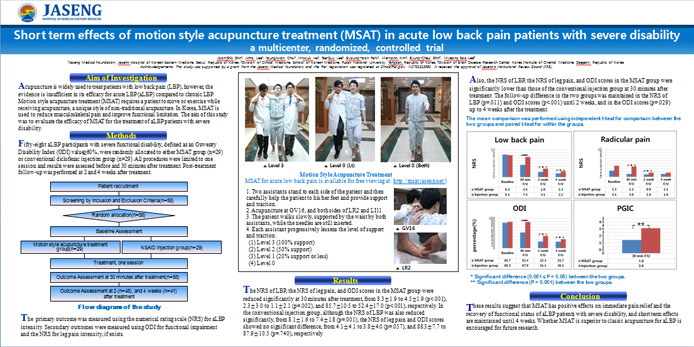The 14th World Congress on Pain
Submission Type: Poster Abstract Submission
Keywords:
1. acupuncture
2. acute pain
3. low back pain
Authors:
- Tae-Gyu Lee, 2. Joon-Shik Shin, 3. In-Hyuk Ha, 4. Jinho Lee, 5. Youngkwon Choi, 6. Byoung-Yoon Park, 7. Me-riong Kim, 8. Byung-Cheul Shin and 9. Myeong Soo Lee.
Institution/Department: Jaseng Medical Foundation, Jaseng Spine & Joint Research Institute
Title:
Short term effects of motion style acupuncture treatment (MSAT) in acute low back pain patients with severe disability: A multicenter, randomized, controlled trial
Submission Body:

Aim of Investigation: Acupuncture is widely used to treat patients with low back pain (LBP), however, the evidence is insufficient in its efficacy for acute LBP (aLBP) compared to chronic LBP. Motion style acupuncture treatment (MSAT) requires a patient to move or exercise while receiving acupuncture, a unique style of non-traditional acupuncture. In Korea, MSAT is used to reduce musculoskeletal pain and improve functional limitation. The aim of this study was to evaluate the efficacy of MSAT for the treatment of aLBP patients with severe disability.
Methods: Fifty-eight aLBP participants with severe functional disability, defined as an Oswestry Disability Index (ODI) value>60%, were randomly allocated to either MSAT group (n=29) or conventional diclofenac injection group (n=29). All procedures were limited to one session and results were assessed before and 30 minutes after treatment. Post-treatment follow-up was performed at 2 and 4 weeks after treatment. The primary outcome was measured using the numerical rating scale (NRS) for aLBP intensity. Secondary outcomes were measured using ODI for functional impairment and the NRS for leg pain intensity, if exists. The mean comparison was performed using independent t-test for comparison between the two groups and paired t-test for within the groups.
Results: The NRS of LBP, the NRS of leg pain, and ODI scores in the MSAT group were reduced significantly at 30 minutes after treatment, from 8.3±1.9 to 4.5±1.9 (p<.001), 2.3±3.0 to 1.1±2.1 (p=.002), and 85.7±10.5 to 52.4±17.0 (p<.001), respectively. In the conventional injection group, although the NRS of LBP was also reduced significantly, from 8.1±1.6 to 7.4±1.8 (p=.001), the NRS of leg pain and ODI scores showed no significant difference, from 4.1±4.1 to 3.8±4.0 (p=.057), and 88.3±7.7 to 87.9±10.5 (p=.740), respectively.
Also, the NRS of LBP, the NRS of leg pain, and ODI scores in the MSAT group were significantly lower than those of the conventional injection group at 30 minutes after treatment. The follow-up difference in the two groups was maintained in the NRS of LBP (p=.011) and ODI scores (p<.001) until 2 weeks, and in the ODI scores (p=.029) up to 4 weeks after the treatment.
Conclusions: These results suggest that MSAT has positive effects on immediate pain relief and the recovery of functional status of aLBP patients with severe disability, and short term effects are maintained until 4 weeks. Whether MSAT is superior to classic acupuncture for aLBP is encouraged for future research.
Acknowledgements / Disclosures:
This study was supported by a grant from Jaseng Medical Foundation.













